Resistance and resilience
Recovering the life and legacy of Yuri Nemoto (’46), Madison’s first Asian American student
Featured Stories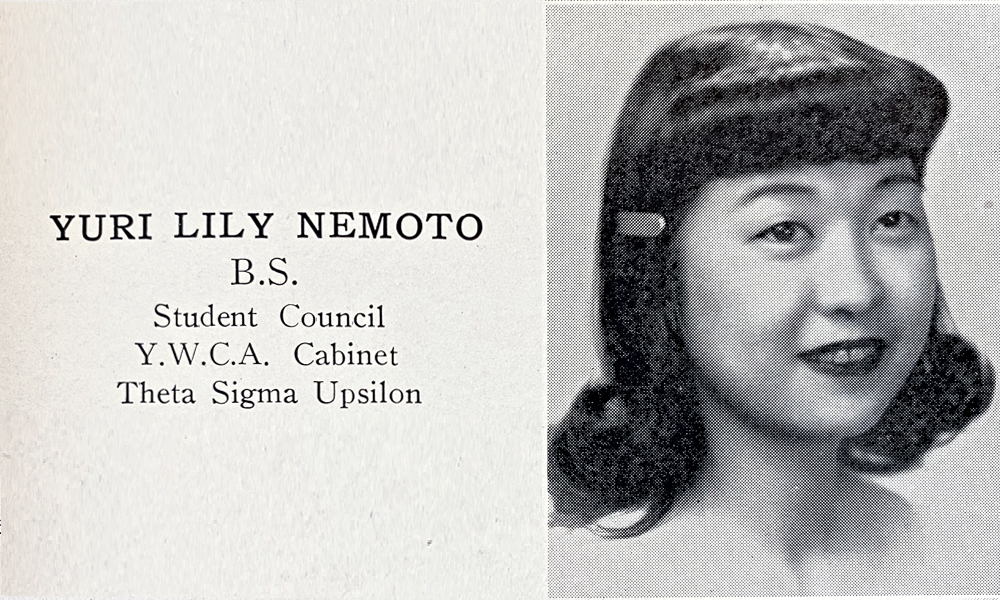
SUMMARY: Yuri Nemoto (’46) was a profile in courage who helped educate her peers and blazed a trail for future generations of Asian American students at Madison College. She arrived in Harrisonburg in 1943 to study Dietetics.
A few years ago, I purchased a 1944 School Ma’am in a local antique store and was astounded to find photographs of a Madison College student named Yuri Nemoto (’46). A quick search of The Breeze turned up a 1943 interview calling her Madison’s first student “of Japanese descent.” In it, Nemoto told the reporter that she was from Los Angeles, came to Virginia on a scholarship to Lynchburg College and transferred to Madison that fall intending to study Dietetics.
Well. I had so many questions after reading that. How had she not been incarcerated along with more than 110,000 other people of Japanese ancestry? What had it been like for a Japanese American to attend an all-white, Southern school during World War II? My research has revealed a compelling story of resistance and resilience.
|
Although hysteria about “enemy aliens” on the West Coast had been building steadily since 1939, few Angelenos expected what came next. |
As the Asian American scholar Leslie Bow noted in Partly Colored (2010), whites in the segregated South labeled many people “colored” besides African Americans — these included Asian Americans, Native Americans, Latin Americans and various ethnic Americans, some of whom received preferential treatment as “near white” even as they experienced prejudice. Importantly, Nemoto enrolled at Madison 23 years before the first Black woman, Sheary Darcus Johnson (’70, ’74M), but 17 years after the first Latin American, a woman from Panama. Nemoto’s story expands and complicates what is known about this institution’s transformation from a whites-only women’s school into a desegregated, coeducational university. Ultimately, though, I hope it can inform how we advance diversity, equity, and inclusion at JMU in the present and future.
Little Tokyo
Nemoto grew up in Los Angeles’ Little Tokyo, then the largest community of Japanese immigrants and their families in the United States. Her father, Moichi Nemoto, arrived as a student in 1904, living first in San Francisco before venturing south. In 1916, he returned to Japan to collect his picture bride, Yai Tsumori. (He called her a picture bride in his naturalization papers.) The couple had the first of five daughters, Hatsu, in 1917, then Kimi in 1919 and Mitsu in 1922. Yuri arrived in 1923, and the youngest, Matsu Florence, was born in 1926. According to her obituary, Yuri Nemoto remembered many aspects of her childhood positively, especially long drives with her parents and sisters.
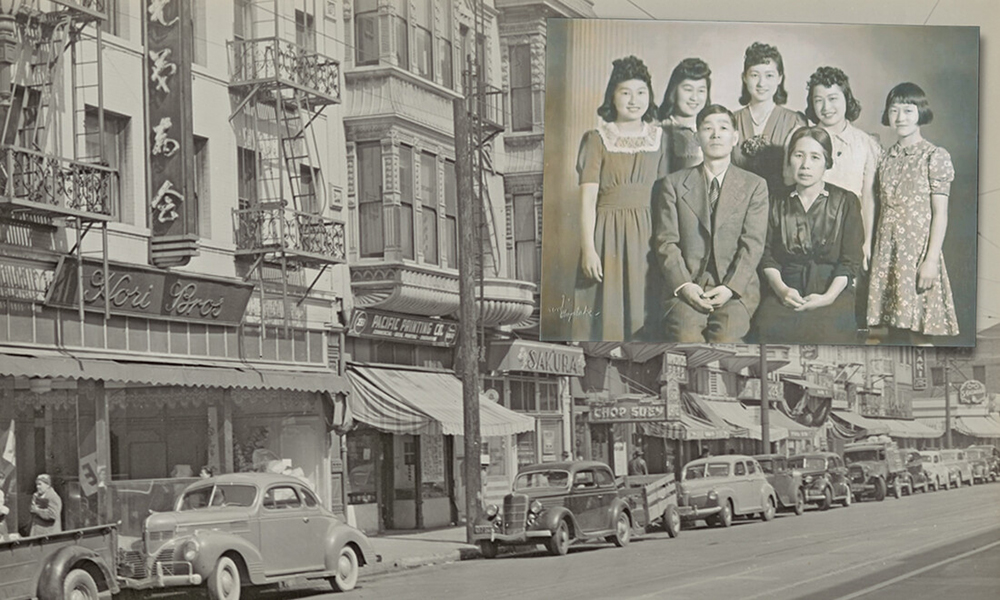 |
| In April 1942, Little Tokyo in Los Angeles was the largest community of Japanese immigrants and their families in the United States prior to the mass removal of residents of Japanese ancestry. Families were assigned to War Relocation Authority centers for the duration of World War II. (Inset): Nemoto family |
Historian Valerie Matsumoto provided a vivid portrait of the Little Tokyo that Nemoto knew. Of the estimated 35,000 persons of Japanese ancestry who lived there during the 1930s, half were Japanese-born Issei and half American-born Nisei. Yuri attended largely segregated schools and probably participated in one of the many social clubs where Nisei children studied Japanese language and culture. Gender expectations for girls were still very restrictive, and modern Nisei women who wanted to work faced great difficulties. After high school, Kimi Nemoto attended Los Angeles Junior College and found employment as a secretary. Hatsu, by contrast, married an Issei man. Yuri’s older sisters provided important role models for her and might have shaped her determination to go to UCLA in September 1941. Although hysteria about “enemy aliens” on the West Coast had been building steadily since 1939, few Angelenos expected what came next.
Mass removal and incarceration
On Dec. 7, 1941, Japanese forces launched a surprise strike against U.S. bases in Hawaii, Guam, Wake Island and the Philippines, intending to prevent U.S. military intervention in the Pacific. Within hours of the attack, FBI agents in Los Angeles, aided by local police, began rounding up Japanese and Japanese-American professionals and businessmen. After President Franklin D. Roosevelt signed Executive Order 9066 in February 1942, entire families received orders to report to so-called assembly centers and bring only what they could carry. Stripped of their civil rights, they had no time to safeguard belongings, businesses or bank accounts. The Nemotos were sent under armed guard to the haphazardly converted Santa Anita racetrack grounds to await removal further inland. Living conditions at all centers were deplorable, especially as the population increased. Santa Anita, with more than 18,000 occupants, was the worst. More than 8,000 people occupied horse stalls that still stank of manure. Altogether, the Nemotos spent five months there.
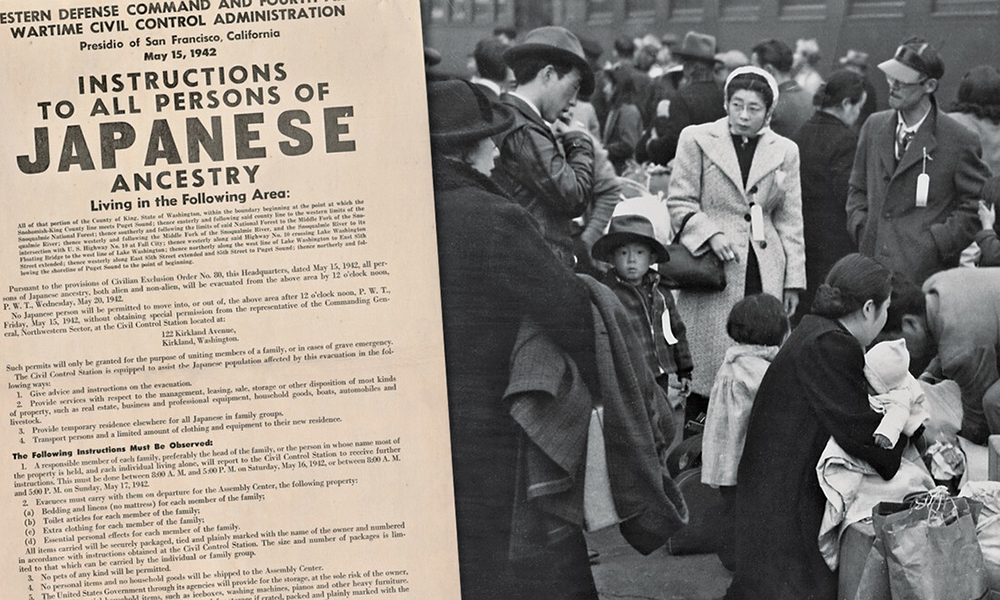 |
| (Left): The removal notice of all persons of Japanese ancestry. (Right): Beginning in 1942, the War Relocation Authority rounded up thousands of Japanese families, boarding them on trains to “assembly centers.” |
While at Santa Anita, Yuri Nemoto received a scholarship to attend the all-white Lynchburg College in Virginia. In her Breeze interview, she explained that her family belonged to the “Disciples Church” [Disciples of Christ] in Los Angeles, that members of the congregation had arranged it for her and that she “was released” directly from the racetrack facility. It must have been so difficult to leave her family and travel as a young Japanese-American woman across the country. Soon after her classes began in September 1942, her parents and sisters were transported to Rohwer, Arkansas. While waiting for mail and phone service at the camp to begin, she worried for their safety and they, hers. In the meantime, Nemoto adjusted to the Jim Crow South and her strange new status as “near white.” White faculty and students at the small, Disciples-affiliated school might or might not have been welcoming. All Nemoto told The Breeze is that she wanted to study Dietetics, and since Lynchburg didn’t have that program, she resolved to transfer.
Rohwer incarceration camp
After her freshman year concluded, Nemoto’s initial release from detention evidently ended, and she joined her incarcerated family for the summer. A camp newsletter, The Rohwer Transmitter, announced her as a “visiting” guest, so it’s clear that she wasn’t staying long. Today, there is nothing left of the camp except the cemetery. When she arrived, however, it was an intimidating, 500-acre complex located in swampy southeast Arkansas, far from any sizeable population centers. Actor George Takei, known for his role as Mr. Sulu in Star Trek, has vivid memories of his long train journey to Rohwer, the barbed wire that surrounded the camp and the sentry tower that loomed over the gate. Inside were 33 residential blocks, each containing 12 unfinished, wood and tar-paper bunkhouses.
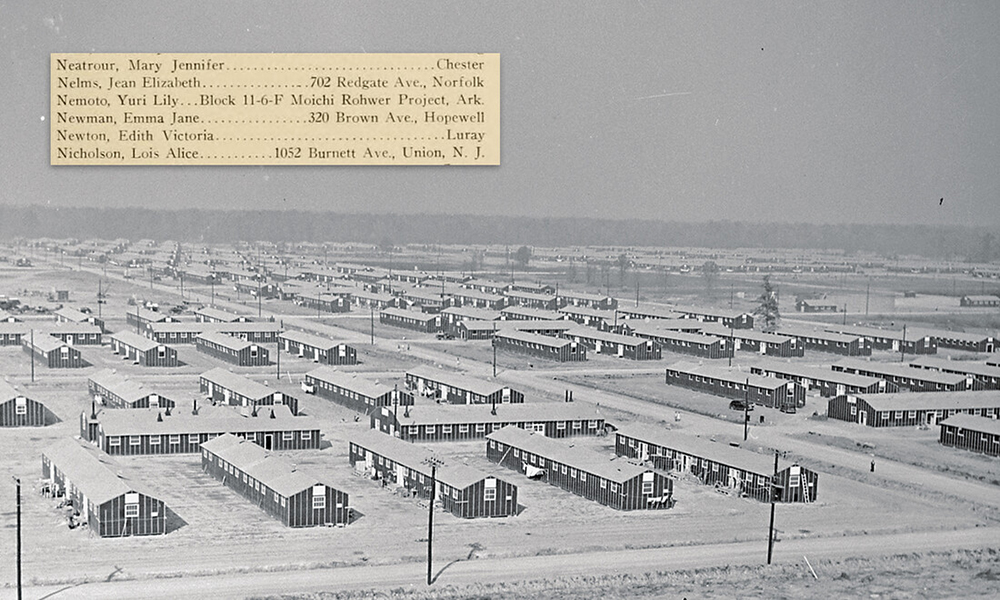 |
| The 1944 School Ma’am (inset) lists Nemoto’s home address as an incarceration camp for Japanese Americans in Rohwer, Arkansas. The 500-acre, barbed-wire camp was comprised of 33 residential blocks. |
The War Relocation Authority claimed the camps were only detaining people temporarily until they could be relocated elsewhere in the U.S. The reality, as many scholars have shown, was very different. Only a small number at each camp successfully received work release. Some got approval to enlist in the armed services or attend college somewhere. Kimi Nemoto, formerly a secretary, was assigned to work at Rohwer as a teacher and telegraph operator. She applied for work release and eventually secured a job in Kansas City, Missouri. Yuri, once again, found her own means of escape.
Madison College
Yuri Nemoto arrived at Madison in September 1943. Given the heightened scrutiny of Japanese Americans and the specific circumstances of Nemoto’s scholarship, her application and matriculation undoubtedly received special attention. Then-President Samuel Page Duke and other administrators would have met with her personally. All of her required Chemistry, Dietetics and cooking classes were held in what was known as Maury Science Hall (now Gabbin Hall). The building was a short walk from her room in Sheldon Hall, one of the residence halls for second-year students. She would have crossed the Quad for meals in the dining hall on the third floor of Harrison Hall, where she would have picked up mail from her family in Rohwer. Though the only Asian American on campus, Nemoto’s experiences at UCLA and at Lynchburg prepared her for the challenge of living with hundreds of white Southern women.
|
Nemoto could have declined to speak at all publicly, but instead, she bravely persisted in her efforts to educate the campus. |
Campus sources suggest how Nemoto acclimated. Her name first appears in print in The Breeze on Sept. 17, 1943, as the little sister assigned to Maxine Duggar, vice president of the college’s Young Women’s Christian Association. The YWCA was among the most important student organizations at Madison. Its annual Big Sister-Little Sister program, started in 1909, required that each new student be paired with an upperclassman who agreed to serve as a mentor and help “in getting adjusted to campus life.” Nemoto’s religious faith afforded her an entrée, that she would not have had if her parents remained Shinto or Buddhist, into the overwhelmingly Protestant campus. In the first week, she attended a YWCA party for the Big-Little Sister pairs, then YWCA vespers (held in Wilson Hall every Friday) and the annual new student reception at the president’s house, Hillcrest, where she first met the faculty. Everyone would have noticed the school’s “first Asian student.”
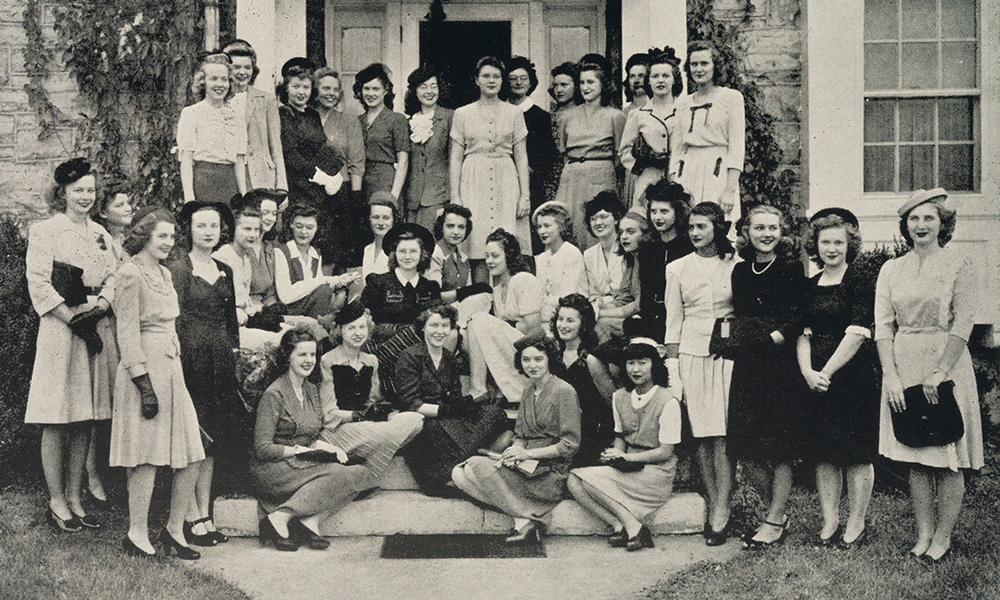 |
| In 1946, Nemoto was an officer in the Frances Sale Club for Home Economics and Dietetics majors. |
Nemoto’s interview in The Breeze on Oct. 1, 1943, soon sparked invitations to address student groups on the subject of Japanese incarceration. She gave her first formal talk to the YWCA in mid-October, then another to Sigma Phi Lambda members in November. It’s not hard to imagine the way she had to navigate the politics of anti-Asian racism with a white audience. In her Breeze interview, she carefully noted, for example, that internment was “for purposes of safety to the country as well as safety to ourselves.” Nemoto could have declined to speak at all publicly, but instead, she bravely persisted in her efforts to educate the campus. She also intentionally joined the International Relations Club, known that year for the frequency of “discussions that turned into debates” as Madison students tried to understand the United States’ role in the global war.
A strong pro-American/anti-Axis powers attitude pervaded everything at Madison during the war years. There was a Campus Defense Council led by Dean of Women Bernice Varner, a victory garden behind the library, campaigns to buy war bonds, bandage rolling parties, and a regular column in The Breeze that summarized news about “Japs” and “Nazis.” When Madison’s white women students went to see movies at the Virginia Theater on Main Street, they saw propagandistic news reels that disparaged people of Japanese ancestry as violent, primitive and “cunning.” In this climate, whites who routinely enjoyed anti-Black minstrel shows, Old South-themed dances and other racist activities at Madison in the 1940s surely displayed prejudice toward Asian Americans, even as some of them accepted Nemoto. She very likely encountered microaggressions all the time, but she might have experienced more direct forms of racism and discrimination, too, such as name-calling, vandalism of personal items, grade deflation or worse.
Nemoto continued her educational campaign into her junior year. In Fall 1944, she organized a special program for the YWCA focused on “world fellowship” and a film series for the IRC in which members considered cultures around the globe. When evaluated as a body, her activities seem connected by the broad theme of human similarities — not differences. This theme was undoubtedly evident in a January 1945 talk she gave to the IRC on “Japanese and Japanese-Americans in the U.S.” Drawing from her experiences, Nemoto “made known to the members many facts concerning the mass evacuation of 110,000 persons of Japanese ancestry” and “gave information about boys of Japanese ancestry serving in the armed forces.” By that time, she was president of the IRC, an officer in the Frances Sale Club for Home Economics and Dietetics majors, and a member of the YWCA cabinet. Her election to these leadership positions indicated her standing in the campus community — so does her induction in April 1945 into Theta Sigma Upsilon, an invitation-only service sorority. But after Victory in Europe Day on May 8, The Breeze offered a sharp reminder of her alien status when the editor urged Madison students to endorse total war against Japan, declaring, “We have to kill the Jap soldier for he won’t surrender. Death on the battlefield is the highest death to the Japs, and it is our own boys who have to fight these tricky, fanatical soldiers.”
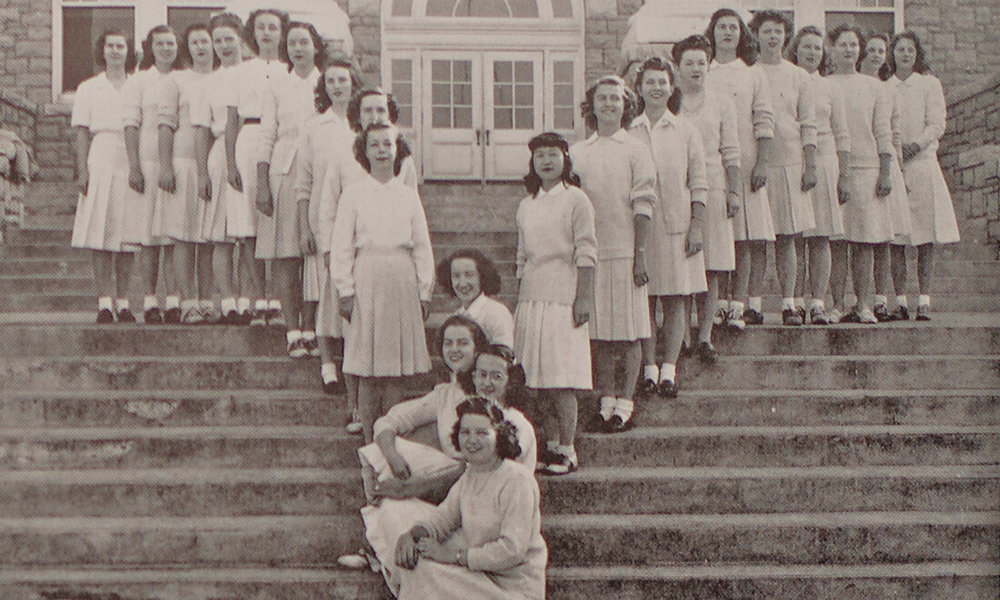 |
| Yuri Nemoto (’46) helped pave the way for Asian American students at Madison. |
I can’t tell if Nemoto returned to Rohwer during the summer of 1945 or not. Severe rationing caused President Duke to cancel spring break a few months earlier because of the national shortage of fuel, and travel remained restricted. Where was she when the U.S. bombed Hiroshima on Aug. 6 and Nagasaki on Aug. 9? Where was she when Victory Over Japan Day was announced on Aug. 14, 1945 and the surrender documents signed on Sept. 2? I wish I knew. It must have been a very difficult summer. By Sept. 15, she was back on campus for her senior year.
Now living in Senior Hall (Converse Hall) and still a member of the YWCA, Nemoto was assigned a little sister, a white woman named Frances Clark Bethel — one of 473 first-years admitted. As a senior, she qualified for a wide array of social privileges, like the ability to return later to campus from a date. While many white men, including newly discharged veterans, enrolled in day classes at Madison, it is unknown if she participated in the post-war frenzy of dating. Historians like Jason Sokol documented the tensions that resulted when white veterans returned to their home communities and resumed old animosities toward Asian American, Latin American and African American neighbors.
Although her family remained incarcerated, Nemoto shifted her public advocacy role. She stepped down as IRC president, for example, and stopped giving talks about the concentration camps. She remained highly visible, however, as a leader of the YWCA cabinet and the Student Council — an elected group that, together with the class officers, formed the Student Government Association. The shift might have been a practical necessity to accommodate her senior coursework, a series of seminars in institutional management, home management and nutrition, along with additional requirements stipulated by the American Dietetic Association. Nemoto’s curriculum also required her to complete a supervised practicum in one of the on-campus dining facilities and then await her final placement in an off-campus facility. Graduation day finally came in May 1946, and I like to think that some of her family members were able to attend.
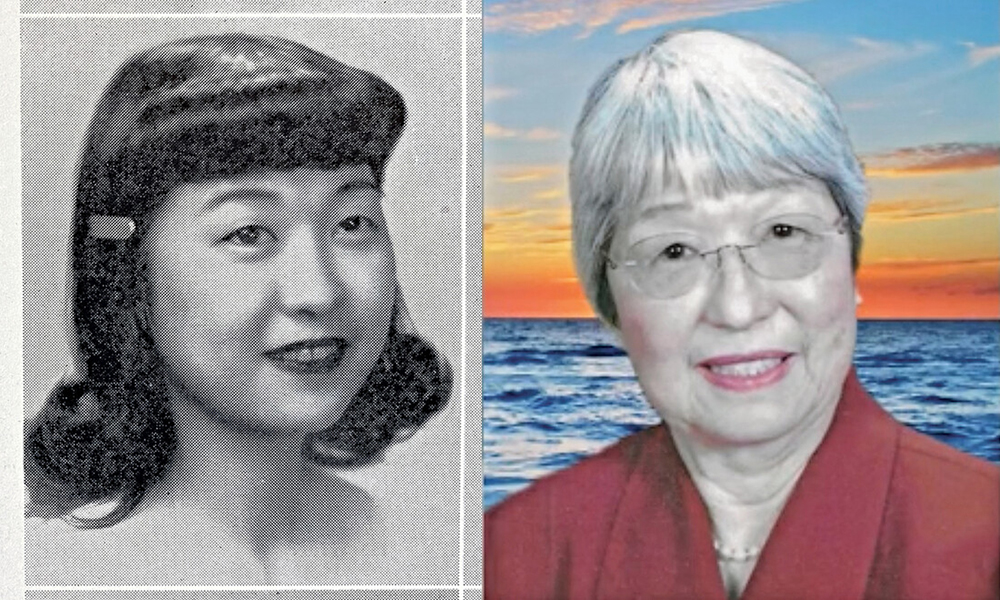 |
| After graduating from Madison, Nemoto had a long career in health care. She died in 2018. |
Legacy: Resistance & resilience
A conventional reading would highlight Nemoto’s “triumph over adversity,” but a truer one would emphasize her resistance and resilience. After graduation, she reunited with her family in Los Angeles, became a wife and mother, and had a long career in health care. Because she passed away in 2018, I can only wonder what she would think of JMU today. She would be pleased to see multiple Asian student organizations, the APIDA Caucus, the Asian Studies minor, Japanese language classes and study-abroad programs in Japan. Yet, she would also see that just 4.4% of JMU undergraduates identify as Asian or Asian American — whereas 74.5% identify as white. And she would know that anti-Asian hate is rising again nationally and globally. This is especially evident in her LA hometown, where a March 2022 survey found that two-thirds of Asian American and Pacific Islander residents fear rising racial attacks. When I reflect on Nemoto’s story, I know she would want us to follow her example and speak out against racism and bigotry. Her memory reminds us of what Being the Change means.
Also a professor of History, Mulrooney chairs the Campus History Committee. Her research on the history of James Madison University plays an integral part in telling the full story of the institution and people connected to it. If you knew Yuri Nemoto (’46) or have a similar story to share, the committee would like to hear from you at campushistory@jmu.edu.

